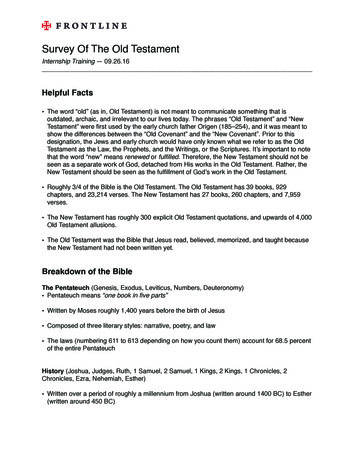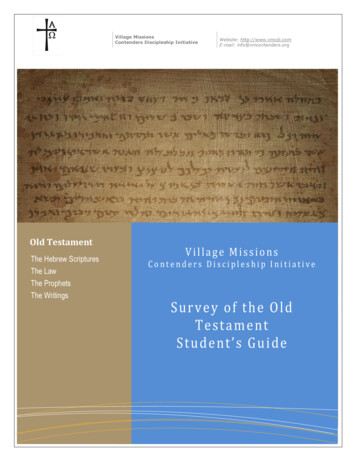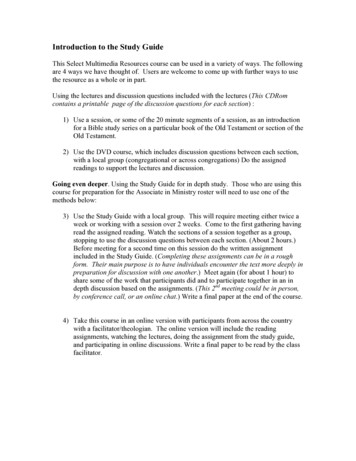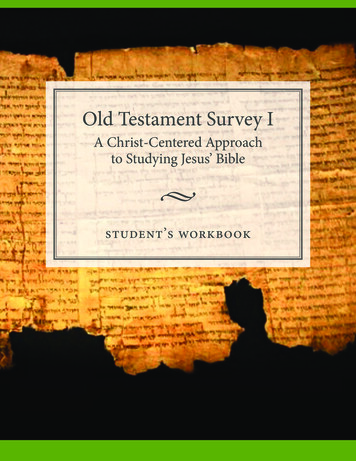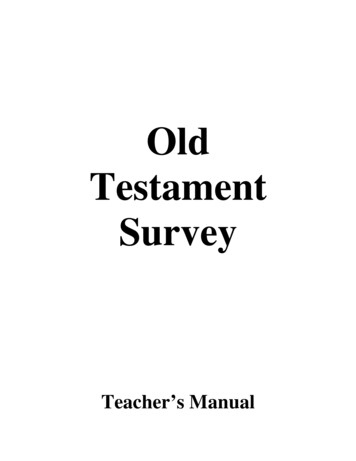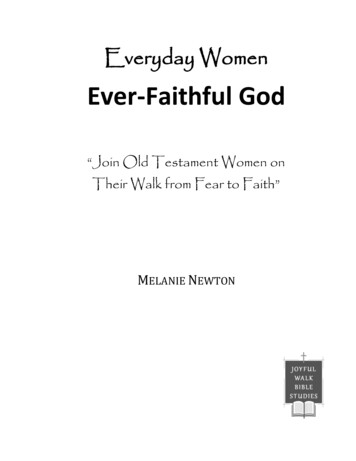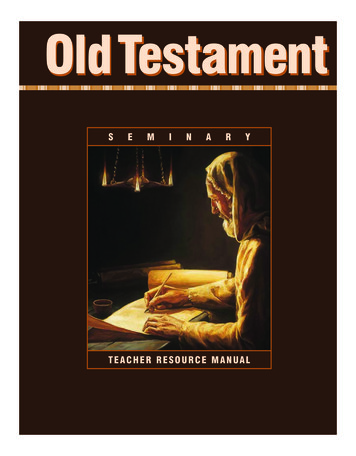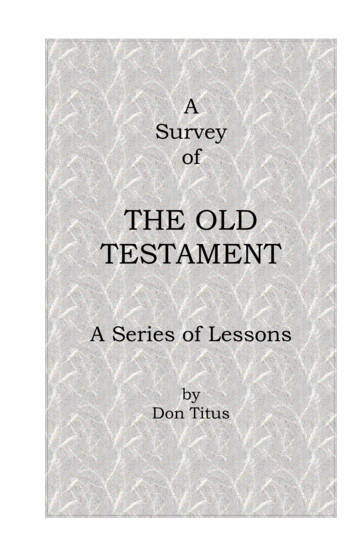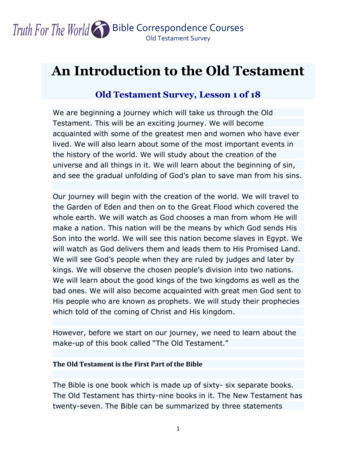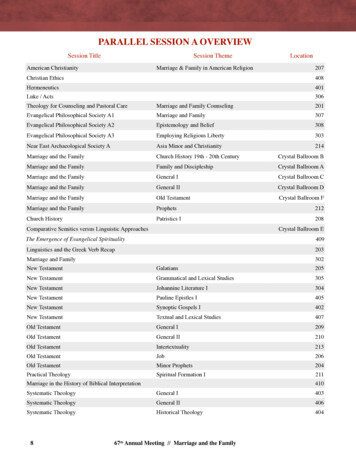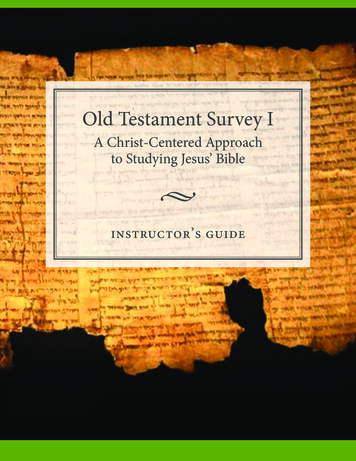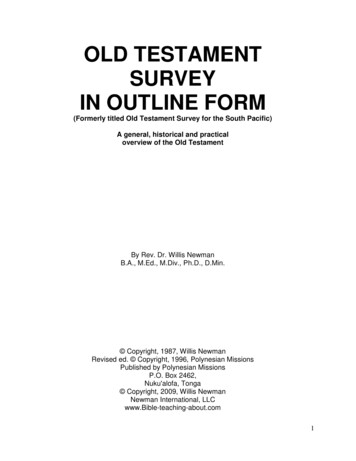
Transcription
OLD TESTAMENTSURVEYIN OUTLINE FORM(Formerly titled Old Testament Survey for the South Pacific)A general, historical and practicaloverview of the Old TestamentBy Rev. Dr. Willis NewmanB.A., M.Ed., M.Div., Ph.D., D.Min. Copyright, 1987, Willis NewmanRevised ed. Copyright, 1996, Polynesian MissionsPublished by Polynesian MissionsP.O. Box 2462,Nuku'alofa, Tonga Copyright, 2009, Willis NewmanNewman International, LLCwww.Bible-teaching-about.com1
INTRODUCTION(1987 edition)This survey manual is a general, historical and practical overview of the OldTestament. It provides a basic working knowledge of the Old Testament along withsome fundamental tools for putting the teaching into practice. This manual is gearedto bring benefit to many: the Bible college student, the layperson, Christian worker,Sunday School teacher, and even the busy pastor will find encouragement andsermon ideas. The advanced student who wishes to explore the major issues indepth will also find direction and help, chiefly by the "basic Bible study library" at theend of manual.The manual may be read along with the Bible in the student's mother languageand with a supplementary text such as The Old Testament Speaks by SamuelSchultz. For those students interested in the critical issues of the Old Testament thetext A Survey of Old Testament Introduction by Gleason Archer, Jr. isrecommended.In the Pacific Rim there are many religions with their "gods;" consequently, thismanual begins with a fundamental statement about the general nature, purpose,structure and theme of the Bible. Included is an introduction to the God of the Bible:who He is, what He does and how He relates to mankind.Next, the flow of the manual is to journey through the historical unfolding of God'splan of redemption in a chronological order. The manual steps through the history ofthe Old Testament from one distinctive period of time to the next. Each of thosesegments are summarized in "snapshot" style and the major events and lessons arehighlighted.Chapter 12 offers the reader a brief outline of each book of the Old Testamentalong with the writer, date, and theme. The manual is meant to be practical; thus, ashort section is given on how to study the Bible as well as how to pass theinformation on to others by way of preaching or teaching.The goal of the manual is to advance the interest of the Lord Jesus Christ: thecompletion of His church through evangelizing the lost and equipping the saints. It ismy prayer that by the power of thethousands may come to know Christ, who is the sole source of eternal life,forgiveness of sin and happiness -- all made possible through His substitutionaryatonement and resurrection from the dead. To Him be glory, honor and praiseforever.I wish to thank Dr. William Kerr, my mentor for many, many years, for his readingof this manual along with offering helpful suggestions and corrections. I also want tothank the following: Mel Erickson who led me to Christ in 1965, my students whohave provided the occasion for the assembling of this information and the scores ofgodly men who have taught me through their lectures or books.Dr. Willis C. Newman,October, 1987Honolulu, Hawaii.2
INTRODUCTION(1996 edition)This edition follows the same format as the 1987 edition. More informationregarding introductory issues has been added, the section on Documentary Theoryhas been modified and inserted as a new chapter. The dating of the OT books hasbeen refined and now reflects that of Ryrie's Study Bible. Minor changes andclarifications have been inserted here and there. The bibliography has been broughtup to date, and an index has been added. My thanks goes to Esmie Mila whoretyped the manuscript.Dr. Willis C. Newman, Nuku'alofa, Tonga, 1996.INTRODUCTION(2009 Edition)In this edition, I have not changed any of the content. I did, however, change someof the formatting for better ease of reading. The ebook started out as simply mylecture notes when I began teaching at International College and Graduate School ofTheology in Honolulu, Hawaii. From that experience, God called me to start aseminary and Bible college in the Kingdom of Tonga, South Pacific. That is where Idid major revision and addition to the work. It seems that one has more time whileliving on a South Pacific island!While serving as a missionary in Tonga, I helped start the teaching site for FaithEvangelical Seminary located in Tacoma, Washington, USA. The Tongan site is stillin business, and under the leadership of Dr. Uili Fukofuka, presently the Director ofEducation for Tonga. Hundreds of students have graduated from the school.In 1998, I returned to the United States where I eventually took up teaching at a localcommunity college, and continue at Faith Evangelical Seminary. I am grateful to Dr.Michael Adams, President of Faith, for the opportunities he has given me.My Filipina wife, Esmeralda, and I are working on this website (Bible-teachingabout.com), which seems like a never ending task. We desire to continue ourmissionary work through training and literature through the internet. The NewmanBible Academy has grown out of this desire and vision from God.Since this ebook is in outline form, I would encourage you to use the internet to findmore detail on various places, people, and events. Although the free Wikipedia is notrecommended by some, I have found it to be helpful in giving general overviews onplaces and people, plus giving excellent resources – many that can be accessed bythe internet. Research has determined it to be fairly accurate. The Christian ClassicsEthereal Library is another excellent tool, and is found at http://www.ccel.org/Dr. Willis & Esmeralda NewmanTacoma, Washington USA, 2009.3
TABLE OF CONTENTSCHAPTERI. INTRODUCTORY OVERVIEWA. The central theme and purpose in the Old Testament .B. The central Person in the Old Testament.C. The basic content of the Old Testament .D. The uniqueness of the Old Testament .E. The relationship between the Old and the New TestamentIntroduction to God.A. The definition and existence of God.B. The matter of creation vs. evolution.C. Some Introductory issues .1. Canon.2. Early civilizations .3. Times and dates .4. Who wrote Genesis.5. Authorship of the Pentateuch.6. Revelation and Inspiration.7. Interpretation.The Bird's - eye overview.A. Great time periods of the Old Testament .B. Various views of the Old Testament.C. The Old Testament Library .PAGE.788910111113161616181820232425252728II. THE HISTORICAL CRITICAL METHOD.A. History and Background.JEDP Documents.Liberal Views of the Bible (selected quotes).B. The Historical Critical Method Explained and EvaluatedC. More about JEDP .D. Why do some Christian leaders reject the Bible?.293131343941III. THE ERA OF BEGINNINGS.A. Creation itself .B. Crown of God's creation: manC. Fall of man .D. Provision for man's salvationE. Growth of the human race .F. First human civilization.G. The flood.H. Spread of mankind .I. Facts and doctrines of great value.464849505051525555IV. THE ERA OF THE PATRIARCHS.A. Abraham.574
B.C.D.E.Abrahamic Covenant, Melchizedek, Sodom and Gomorrah, test of faith.Isaac .Jacob and Esau.Sequence summary of major events.Messianic line .V. THE ERA OF EGYPT.A. The career of Joseph.Brothers, Potiphar's wife, prison, famine, family reunion, his example.B. The Messianic line continues.C. The birth of a nation (Israel).Israel enslaved, Moses, plagues, Passover, Exodus.VI. THE ERA OF WILDERNESS WANDERING.A. Organization of Israel.Ten Commandments, tabernacle, priesthood, sacrifices, feasts.B. Travels of Israel.Promised Land, 12 spies, desert life, Balaam.VII. THE ERA OF SETTLEMENT.A. Invasion of Canaan .Rahab, crossing Jordan, Christ, Jericho, Achan's sin, trickery.B. Dividing the spoil.Conquest, Caleb's request, cities of refuge.C. Significant observations.Canaanites, faith-walk, Joshua and leadershipVIII. TH ERA OF THE JUDGES.A. Cycles of apostasy and deliverance.Gideon, Samson and Delilah, Angel of the Lord.B. Story of Ruth .C. Transition by Samuel.Prayers of Hannah, successful judges -- poor fathers.D. Spiritual applications.Backsliding, prayer, .90.91.92.93.94IX. THE ERA OF THE UNITED KINGDOM.A. King Saul.His failure, the Holy Spirit in the Old Testament.B. King David .Davidic Covenant, lust, murder, repentance - also a spiritual giant!C. King Solomon.Loved God, great leader, wise, women, wealth, believer's sin nature.D. Literature of the era .Job, Psalms, Proverbs, Ecclesiastes, Samuel, Kings, Chronicles.5
X. THE ERA OF THE DIVIDED KINGDOM.A. Kings of the divided kingdom.Strife, decline, hard preaching by prophets, some revival.B. Prophets of the divided kingdom .Nature of the prophecy.C. Pre-exile prophets .99.99.100.106.108.109XI. THE ERA OF CAPTIVITY.A. Historical context of captivity.Assyria, Babylon, Persia, Egypt -- great events, battles, kings.B. The captivity itself.Israel's and Jerusalem's fall and peoples dispersed.C. Prophets of the captivity.Daniel, Ezekiel, the responsibility of man, soul-winning.XII. THE ERA OF RESTORATION.A. Return of Zerubbabel.B. Ministry of Haggai and ZechariahC. Story of Esther.D. Return under Ezra .E. Return under Nehemiah.F. Preaching of Malachi .112113115115116XIII. BRIEF OUTLINE OF OLD TESTAMENT BOOKS.Pentateuch: Genesis - Deuteronomy .History: Joshua - Esther .Poetry: Job - Songs of Solomon.Major Prophets: Isaiah - Ezekiel.Minor Prophets: Daniel - Malachi.118119123125126IVX. HELPFUL TOOLS FOR THE BIBLE.A. Some general facts about the BibleB. How to study the Bible.C, How to teach/preach the Bible.131132133A BASIC BIBLE STUDY LIBRARY.137CHRONOLOGY AND TIME LINE .HOW TO BE SAVED.143INDEX.144.To get the most out of this study, it is good to read the Bible sections related to eachera, and then study this outline for an explanation of the biblical text.6
CHAPTER I: INTRODUCTORY OVERVIEWI begin this introductory section by summarizing a great deal of information into ashort space. Consequently, the flow is somewhat choppy, but the bare essentialsare here. The material is presented in an outline format.After covering such issue as the central theme, purpose and person of the OldTestament, I give a brief definition of who God is. This is important, because thismaterial is going to the entire world. There are many ideas of who God is, and thatmakes it important to identify who is the God of the Bible.Included in this first section, I also give a brief overview of the history and culture ofthe origins of humanity, and the uniqueness of the Old Testament. The last issue Icover in this chapter is to give a global birds-eye-view of the Old Testament alongwith an Old Testament library – a grouping of the several books of the OldTestament.Let‟s get started. Be sure to read slowly, because there is an enormous amount ofmaterial crammed into this short space. A hint: for some issues you may want toexplore in more detail, you can find more information at Wikipedia. Some maydisagree with the Bible, but you will gain a larger view of the context of the OldTestament in terms of geography, history and culture.A. THE CENTRAL THEME AND PURPOSE IN THE OLD TESTAMENT.1. The Old Testament is the story and history of redemption -- the preparation ofthe world for the "fullness of time" (Gal 4:4). Its emphasis is on God's preparation forthe Incarnation through His Divine dealings with Israel in which the climax was to bethe coming of God manifest in the flesh. (John 1:14-18).2. God's dealings with mankind through Israel are based on the most importantcovenant (contract) ever made between God and man, the Abrahamic Covenant(Gen 12:1-3; 15:17, 18; 17:1, 2). All of God's redemptive dealings with mankind would flow from thiscovenant. All the redemptive dealings would come through the life and history of thisone nation -- Israel (John 4:22). Salvation would come by grace through faith based upon the coming ofthe Messiah. Messiah would come through Israel and through Him allnations would be blessed (Gen 12:1-3; 17:1-8; Acts 3:13-15,18,21,24-26;4:10-12; 13:44-48; Rom 1:16; 15:9-12; Chapter 4).3. The purposes of the Old Testament. To reveal God, that He is one, the Creator and Sustainer of the universe(Isa 40-44:8; Deut 6:4; Gen 1:1). To reveal mankind‟s sinful condition (Rom 3:9-19).7
To hold man accountable to God (Rom 3:19).To reveal knowledge and truth to man (Rom 2:20).To reveal and prove (through fulfilled prophecy) to man God's promise andonly provision for salvation. His salvation was to be through theincarnation, a truth set forth in history, prophecy, type, symbol (Rom 1:1-4;15:8; I Co 15:1-4; Isa 53; John 14:6).To lead men to salvation through faith in Christ (2 Ti 3:15; Gal 3:22-24).To produce saving faith and spiritual growth in man (I Pe 1:23-2:2; Rom12:15-17; 2 Ti 3:16, 17; Psa 119).To be God's instrument to accomplish His purpose in the world (Isa 55:811).To give hope to the nation Israel (Rom 11:25-27; Isa 60).To announce judgment upon the world (Isa 24-27).To announce to Israel promises of blessing for obedience and punishmentfor disobedience (Lev 26).To control very wicked people (1 Ti 1:8-10).To give examples and hope to our Christian living ( Rom 15:4; 1 Co 10:11).To announce God's purpose in saving men: to have a society of redeemedpeople holy unto their God and zealous for good works (Titus 2:14; 1 Pe1:9, 10).To give mankind an orientation of God's plan for Him throughout eternity -a sense of identification and purpose in this life and the next.B. THE CENTRAL PERSON IN THE OLD TESTAMENT.1. The central person in the Old Testament is the Messiah -- Jesus Christ (Acts3:13-15, 18, 21, 24-26; 4:10-12; Acts Chapter 7).a. Messiah was to be a political savior and to rule Israel as an earthly (butsuperhuman) King. Messiah was to come from David, based on the DavidicCovenant, and Jesus is the fulfillment of that covenant. Christ will assume thatthrone at His second coming (Acts 1:6; 15:14-18; Jer 23:5,6; Isa 9:6,7; Luke 1:32,33;Matt 2:2,5,6; 25:7; 2 Sa 7:12-16).b. Messiah was to be a suffering savior to save His people from their sin (Psa22:6; Isa 53; Matt 1:21, 23; 17:11, 12; Mark 9:11-13; Acts 2:22-36; 3:18; John 1:29).2. Christ is revealed in the Old Testament as the central figure in God'sredemption story. Anticipated in prophecy (e.g., Isa 7:14; 9:6, 7; 53; Acts 3:18; Zech 11:12,13; 13:6; Psa 22; 16:9, 10). Symbolized in the sacrificial system (see book of Hebrews). Foreshadowed in the Old Testament types.C. BASIC CONTENT OF THE OLD TESTAMENT.1. God's promise to Abraham (Gen 12:2).The basic thought here is that through Abraham God would found the Hebrewnation for the purpose of bringing great blessing to all the nations through the8
promised Messiah. Israel was to become the messianic nation. The ultimateobjective: to bring Christ into the world. The immediate objective: to establish in aworld of idolatry that there is one true living God.2. God's covenant with Israel (Exod 19:5-8).The fundamental thought in the contract: if Israel followed God, then He wouldprosper and bless them, but if they forsook Him, He would punish and ultimatelydestroy them as a nation. Yet, even though punishment would come, God promisednever to completely destroy the nation and even to restore the nation.3. God's promise to David (2 Sa 7:16).This promise to David is that his familywould rule over God's people forever; thus, through David (the messianic family)would come the Messiah (Jesus Christ).4. The central land of the Bible story is Palestine; the central city is Jerusalem.The central event in history and the Bible is the appearance of Christ. The O.T.prepares the stage for this event; the NT explains and describes the event.D. THE UNIQUENESS OF THE OLD TESTAMENT.1. Its unique claims.It (along with the New Testament) claims to be the revelation from God, Godbreathed (2 Ti 3:16) and inspired in a different sense from all other literature (2 Pe1:20, 21). It discloses the plans and the purposes of God for time and eternity. Jesus called the Old Testament "the Scriptures" (Matt 21:42; Mark 14:49;John 5:39). Jesus' followers called the Old Testament "the Scriptures" (Luke 24:32;Acts 18:24; Rom 15:4). Paul called the Old Testament the "Sacred Writings" (2 Ti 3:15); "HolyScriptures" (Rom 1:2); "Oracles of God" (Rom 3:2). Jesus referred to the formal arrangement in the Hebrew Bible as "the Lawof Moses, Prophets, Psalms" (Luke 24:44). He also excluded theApocryphal books (as did Josephus and Jerome) and said the O.T. spokeof Him; consequently, Jesus is the theme of the Old Testament. It claims to have absolute authority over the lives of men (Romans 3:19).2. Its unique construction. The Old Testament is part of one book, the Bible. The Old Testament is made of 39 separate books, each complete by itselfand united around the one central theme of the whole Bible. The OldTestament was written by at least 30 men (perhaps over 100) over a 1,000year span.3. Its unique focus and content. It tells of: The story of mankind. The person of Jesus Christ. The story of redemption.9
The explanation of spiritual beings and metaphysical realities.The literal accuracy of its content.The ability to meet the needs of the human heart.The fact of its longevity.The authoritative manner of its writing: "thus saith the lord."The fact of its universal acceptance.The impact for good on society.The making and fulfilling of prophecy.The frankness when speaking of its heroes.The ability to radically change a human being.The hope it gives to mankind.The fact of its universal applicability to culture, class and history.Of the Bible, there is no other book like it in all history!E. THE RELATIONSHIP BETWEEN THE OLD AND THE NEW TESTAMENT1. The Old Testament is a testimony to Christ (Luke 24:27, 44; Matt 1:1; John.1:45; 5:39, 46; Acts 10:43). As promised redeemer. The Pentateuch pictures Christ as the perfect man who fulfills the Law. The sacrificial and priestly provisions picture Christ as the messianic priestand sacrifice for sin. The Davidic kingdom pictures as the perfect king. The office of prophet pointed toward Christ the perfect prophet (Acts 3:2226; Hebrews 1:1, 2).2. The New Testament sets forth Christ as the fulfillment of all the Old Testamentpictures, predictions and preparations for the coming Messiah (Matt 1:18-23).3. The New is in the Old concealed; the Old is in the New revealed.4. The New is in the Old contained; the Old is in the New explained.5. The New is in the Old enfolded; the Old is in the New unfolded.6. Everything in the New Testament is found in the germ form in the OldTestament. The Old Testament is referred to 639 times in the NT7. The terms "old" and "new" have been used since the second century todistinguish between the Hebrew and Christian Scriptures. Both testaments are ofequal inspiration and authority. However, the Old Testament is written for theChristian while the New Testament is written to the Christian. The Old Testament iswritten to the Jew.10
8. The names came about because of the focus on the Old Covenant (Mosaic,Exod 24:8; Deut 5:1-5; 2 Ki 23:2; 2 Co 3:14; Gal 3:19; Heb 8:13), and the NewTestament (Matt 26:28; 27:51; Mark 14:24; Luke 22:20; 1 Co 11:25; 2 Co 3:6; 1 Ti2:5; Heb 7:22; 8:6-13; 9:15). The "Old Covenant" was between Israel and God and was conditional,that is, "if" Israel would obey the commandments they would receivecertain benefits (Exod 19:5). The Christian is not under the conditionalMosaic covenant. The "New Testament" rests upon the sacrifice of Christ and secures theeternal blessedness under the Abrahamic Covenant of all who believe.This covenant is unconditional, final, irreversible, and no responsibility isby it committed to man. The Christian is under the New Covenant. In thekingdom age the New Covenant will also be applied to Israel.A SHORT INTRODUCTION TO THE GOD OF THE BIBLE.A. DEFINITION AND EXISTENCE OF GOD.One cannot fully define God in the sense of a complete understanding andknowledge of Him, but man can know exactly and accurately some things aboutGod. Among those knowable things about God is his existence and fundamentalqualities or attributes. Listed below are various attempts to define God in the lattersense.1. Westminster Shorter Catechism: "God is a spirit, infinite, eternal, andunchangeable in His being, wisdom, power, holiness, justice, goodness and truth."2. Augustus Strong, Systematic Theology (p. 52): "God is the infinite andperfect Spirit in whom all things have their source, support, and end."3. The writer's expanded statement: There is but one living and true selfexistent God who is infinite, eternal, omniscient and unchangeable in His being,wisdom, omnipotence, holiness, justice, perfection, love, sovereignty, spirit, mercy,grace, goodness and truth. He is absolutely separate and above the universe as itsCreator, yet everywhere present in the universe as the upholder of all things. He isone in essence, but eternally existent in three persons, Father, Son, and Holy Spirit,each having precisely the same worship, confidence and obedience and who coequally and co-eternally share in the one common nature (Gen 1:26; Deut 6:4; Psa139:8; Isa 45:5-7; Mark 10:18; Matt. 28:19).4. Proofs of God's existence. The belief in God by the human race through history and across culture isuniversal and intuitive -- man assumes the existence of God and evenmust suppress that inner awareness to walk in disbelief (Romans 1:1820).11
The existence of God is assumed by the Scriptures: "the fool has said inhis heart, there is no God" (Psa 14:1). Various arguments for the existence of God.1. The observation that everything must have a cause in order to happen,and ultimately must have a first cause -- God: "Every house is built bysomeone; but he that built all things is God" (Heb 3:4).2. The observation that everything in the universe is seen as having orderand useful arrangement that implies that it was designed with intelligenceand specific purpose by the first cause which was God, "He that plantedthe ear, shall he not hear? He that formed the eye, shall He not see?"(Psa 94:9).3. The observation that all mankind has an idea of God Who is the MostPerfect Being. A Perfect Being necessarily requires existence; therefore,God would have to exist.4. The observation that our conscience admits to the existence of a GreatLawgiver and the punishment of those who break His absolute Law (Rom1:19, 32; 2:14-16).5. The observation that the existence of God best explains the nature ofthings: the moral, mental and religious constitution of man plus the variousrelationships and the things of the material universe.5. The activities of God.a. God created the universe out of nothing in six, literal 24 hour days and withthe appearance of age. He created everything in the universe: physical and spirituallaws, forces, beings, the invisible and the visible worlds and their inhabitants. Heholds the universe in existence and together and has fixed certain all things thathave and will come to pass.He sovereignly rules over all that exists, working through subordinate powers,causes, forces, means and miracles. God arranged together all things and directsthe course of all events in keeping with His one eternal plan and the purpose thatultimately is to bring glory Himself, even by permitting evil to enter the universe.b. God is holy and just (and full of loving-kindness and mercy) and is theabsolute and perfect standard of righteousness (that which judges a thing to be rightor wrong) from which flows His moral law by which all mankind will someday bejudged and held accountable for their deeds while on earth. The law of God hasjudged everyone guilty and under the penalty of everlasting punishment.c. Sin came into the universe by permission of God through the rebellion ofSatan, once a high ranking angel of God's. Sin entered the world through the12
temptation of Satan to Eve, the wife of Adam, the first humans on earth who werecreated by God in His own image, apart from the animal world. Adam and Eve werein a state of unconfirmed holiness.The first human couple disobeyed the command of God and death (Bothspiritual and physical) came upon the human race and the world. The entire humanrace has flowed from the genes of Adam and Eve and all peoples have carried withthem the sin nature. All mankind is guilty of the sin of Adam and Eve plus their own.d. In His great love and mercy, God provided a means of salvation by thegracious action whereby He prepared and sent a Redeemer into the world to savefrom sin all those who put their trust (faith) for salvation into the Savior on the cross.This Redeemer is Jesus Christ of Nazareth.Through His death, the penalty of sin was paid. Through Christ's resurrectionthose saved may have eternal life. Jesus Christ (the second Person in the Trinity) isGod in the flesh (incarnate). (See 1 Pe 1:9-12; Rom 3:25).e. God is now in the process of reclaiming that portion of His kingdom which Hehas given to man who lost it by default to Satan. God is also in the process ofbringing into being a people being conformed into the image of Jesus Christ, the firstborn of many brethren (I Co 15:20-23).B. THE MATTER OF CREATION VS. EVOLUTION.1. Evolution defined: a series of progressive changes effected by means ofresident forces resulting in the development of the more complex forms of life fromthe simpler.2. Claims and assumptions of evolution. The universe began anywhere from 600 million to 25 billion years ago. Life began about 3.5 billion years ago. Life began from inorganic matter and gradually evolved into complexforms of beings. For evolution to be considered, one must necessarily assume God did notcreate the universe. Peter said they, "willingly" assumed evolution (2 Pe3:4). Matter is eternal, no god or force brought matter into existence.3. Response to evolution. The Bible rejects macroevolution as a valid explanation for the origin of theuniverse and its contents and/or the physical or life processes presentlyoccurring.13
Creation is accepted by faith (Heb 11:3, 6). Evolution is a religion accepted and based on faith. Many statements byevolutionists themselves can be presented that state the fact that evolutionis based on faith. Dr. Paul LeMoine, an editor of L'Encyclopedie Francaisand one of the most prestigious scientists in the world, claims thatevolution is "a fairy tale for adults". Bible and science do not conflict. No evidence categorically disproves theBible or shows it to have scientific error. Scientific theory and facts mustbe kept separate.4. Reasons why evolution cannot be true.a. Evolution cannot explain the beginning of the universe. Atheisticevolutionists discount the fact of God and insist that matter is eternal. The key is this:if matter is not eternal, then there must have been a God to create matter. Since tothe Atheist, God cannot exist, then the only option for them is to claim matter iseternal.More and more, however, science has discovered that matter cannot beeternal. The "Big Bang" theory will not explain the origin of the universe, becausethere had to have been a first "big bang" – or something to go, “bang”. The scientificfacts and laws of physics totally rule out the possibility of an "oscillating universe", sothe universe had to have had a beginning -- thus, there is a God.b. Evolution cannot explain the beginning of life. Evolutionists have saidthat life began by spontaneous generation, or else a primordial soup of organicchemicals. According to modern scientific testing, the necessary atmosphericcondition (one free of oxygen) was not in existence for the required chemicalactions. Further, according to scientific law, life by spontaneous generation isimpossible.c. The probabilities of the origin of life by chance are impossible. The lawsof probabilities destroy the possibility of evolution taking place by chance.Creationists have long maintained this fact, but now Francis Crick (the co-discovererof DNA) and Sir Fred Hoyle (the Founder of the Big Bang theory) discount thepossibilities of a cell coming into existence by itself on this earth.Hoyle maintains that life would never have originated by chance in the universein 20 billion years. He concluded that (by scientific and mathematical computations)the only way life could come into existence in the universe was by what some calledGod!d. Evolution cannot produce transitional forms ("missing link") betweenspecies. In October, 1980 at a world meeting of evolutionists in Chicago, Dr.14
Stephen Gould (Harvard) and Dr. Nils Eldredge (American Museum of NaturalHistory) admitted that there are no "missing links" and that Paleontologists haveknown this for years! Gould is an outspoken advocate for evolution. (Of course, theydid not admit to the God of creation.) To repeat, in the fossil record, there are noundisputed transitional forms (missing links) between species.If evolution was true, there should be millions of missing links. We mustconclude that there is no evidence for evolution.e. Evolution is based in naturalism. Darwinian evolution is grounded in aphilosophy known as "naturalism." As a starting point, naturalism assumes that thesupernatural (God) does not exist, or if He does He is not active in this universe.Naturalism assumes what needs to be proven.f. There is no mechanism for evolution to work. Natural selection andgenetic mutation are not a sufficient mechanism for the transition of one species(kind) to anoth
the origins of humanity, and the uniqueness of the Old Testament. The last issue I cover in this chapter is to give a global birds-eye-view of the Old Testament along with an Old Testament library – a grouping of the several books of the Old Testament. Let‟s get started. Be su
